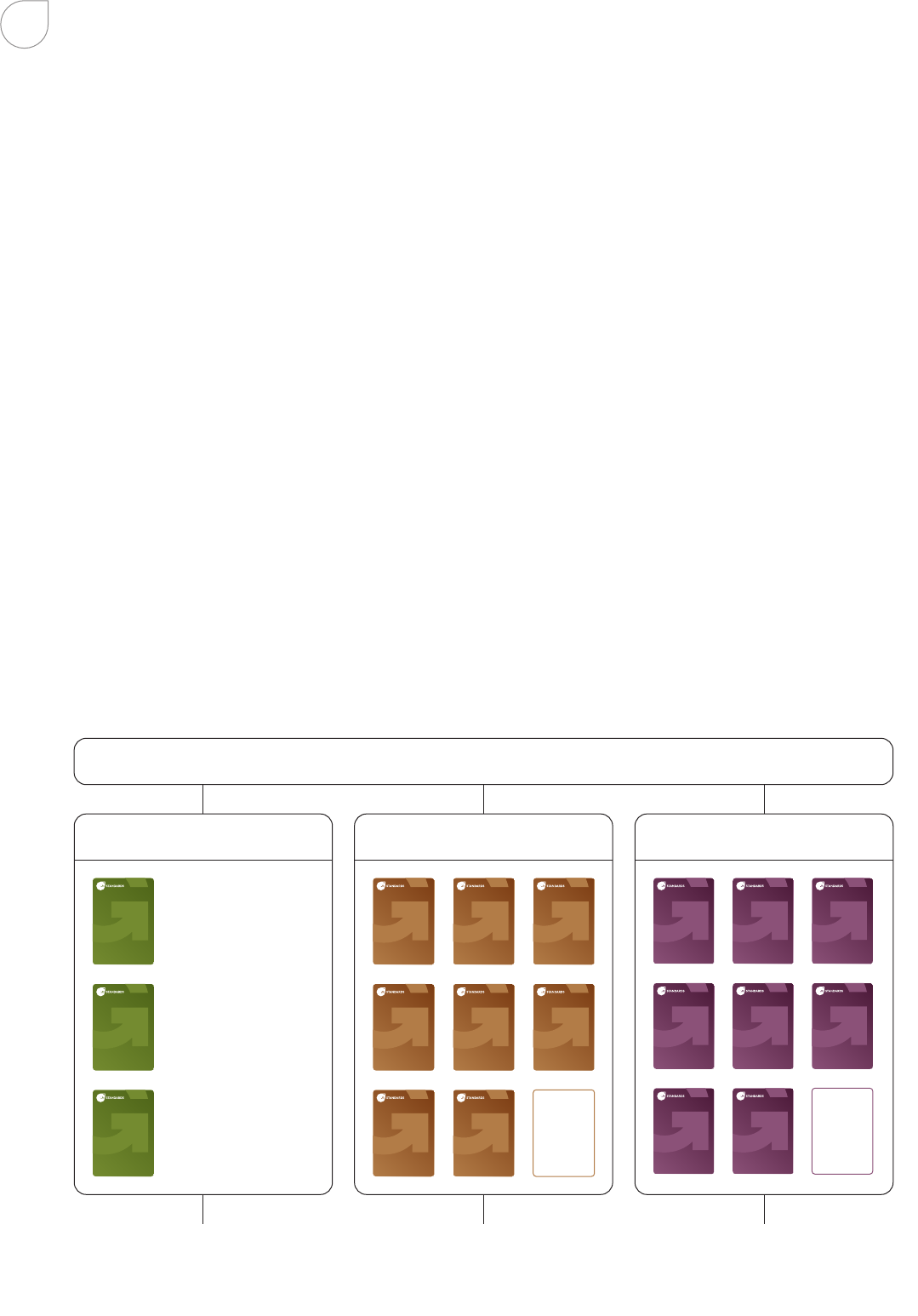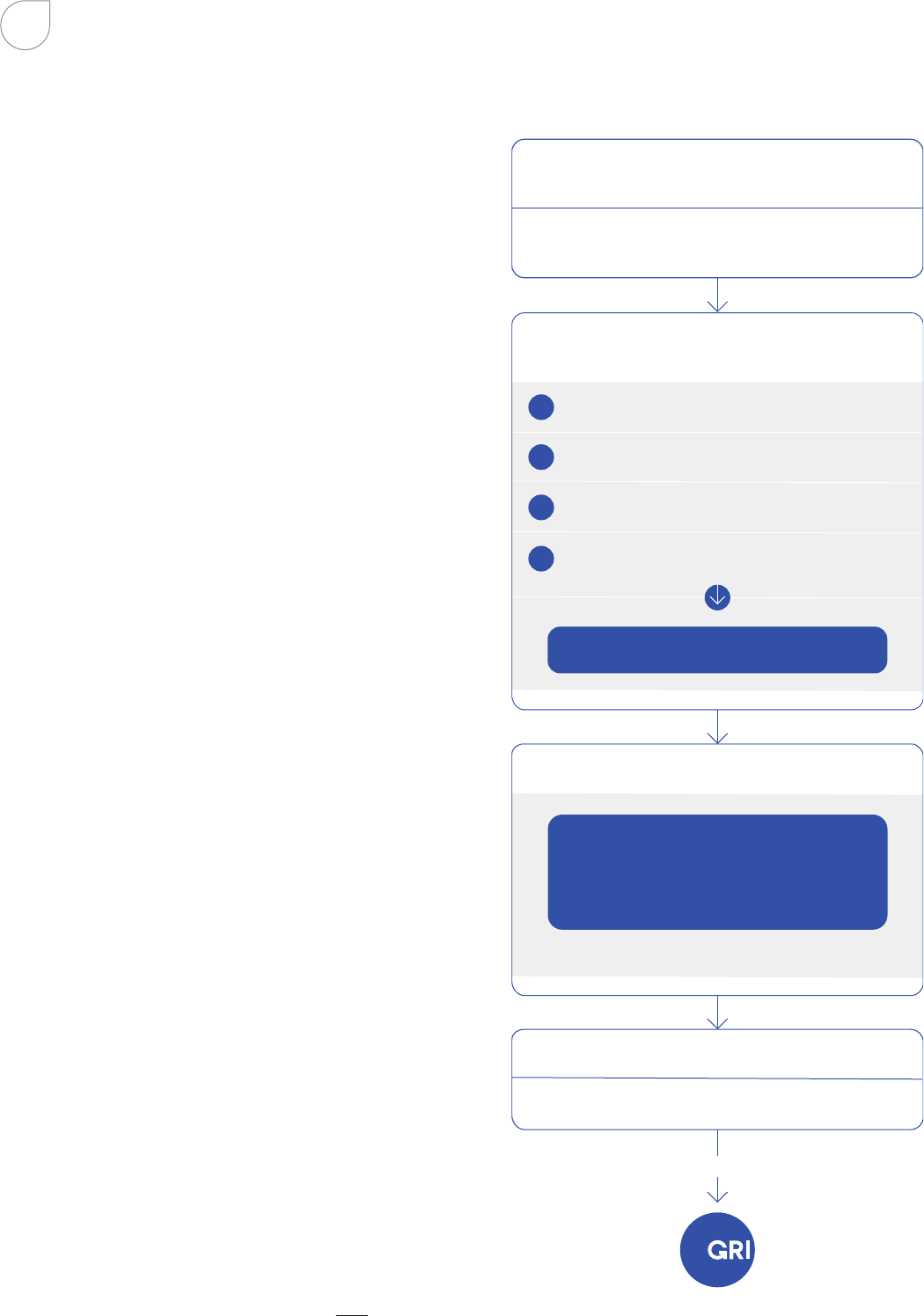
A Short Introduction to
the GRI Standards
www.globalreporting.org www.globalreporting.org

2
A Short Introduction to the GRI Standards
Introduction
The GRI Standards are a modular system
of interconnected standards. They allow
organizations to publicly report the
impacts of their activities in a structured
way that is transparent to stakeholders
and other interested parties.
This Short Introduction will:
• give new users of the GRI Standards an overview
of how the Standards are set up, and equip them to
start working with the various elements involved in the
reporting process;
• be of assistance to experienced users in gaining an
understanding of changes in the system and the role of
the GRI Sector Standards; and
• aid stakeholders and other information users (such
as analysts and policymakers) to understand how the
reporting process works and what to look for in a report.
Three series of Standards support the reporting process:
the GRI Topic Standards, each dedicated to a particular
topic and listing disclosures relevant to that topic; the GRI
Sector Standards, applicable to specific sectors; and the
GRI Universal Standards, which apply to all organizations.
Using these Standards to determine what topics are
material (relevant) to report on helps organizations
indicate their contributions – positive or negative – towards
sustainable development.
Who uses the GRI Standards, and who
uses the reported information?
Any organization, large or small, public or private, from
any sector or location, can use the GRI Standards.
Reporters, stakeholders, and other information users draw
on the Standards.
Reporters within an organization use the Standards to
report on the organization’s impacts in a credible way
that is comparable over time and in relation to other
organizations. The Standards also help stakeholders
and other information users understand what is expected
from an organization to report on and use the information
published by organizations in various ways.
The organization can use the disclosed information to
assess its policies and strategies or to guide decision-
making, such as setting goals and targets. Stakeholders
can also use this information. For example, investors
can use the reported information to assess how an
organization integrates sustainable development into
its strategy to identify financial risks and evaluate its
long-term success. The information provided can also
help other information users, such as analysts and
policymakers in benchmarking and forming policy, and
academics in their research.
The Structure of the GRI Standards
The GRI Standards are a modular system
comprising three series of Standards: the
GRI Universal Standards, the GRI Sector
Standards, and the GRI Topic Standards.
Each Standard begins with a detailed
explanation of how to use it.
The Standards contain disclosures, which provide a
structured means for an organization to report information
about itself and its impacts.
The disclosures can have requirements and can also
include recommendations. Requirements list the
information an organization must report or instructions
it must comply with and report in accordance with the
GRI Standards. Recommendations indicate that certain
information, or a particular course of action, is encouraged
though not compulsory.
Guidance to facilitate understanding can include
background information, explanations, and examples.
GRI Universal Standards
The GRI Universal Standards apply to all organizations,
and consist of the following:
• GRI 1: Foundation 2021 (GRI 1) outlines the purpose
of the GRI Standards, clarifies critical concepts,
and explains how to use the Standards. It lists the
requirements that an organization must comply with to
report in accordance with the GRI Standards. It also
specifies the principles – such as accuracy, balance,
and verifiability – fundamental to good-quality reporting.

3
A Short Introduction to the GRI Standards
...
Apply all three Universal
Standards to your reporting
Use the Sector Standards that
apply to your sectors
Select Topic Standards to report
specific information on your
material topics
Sector StandardsUniversal Standards
...
Topic Standards
GRI 201
GRI 415
GRI 304
GRI 403
GRI 303
GRI 205
GRI 305
GRI 202
GRI 13
GRI 16
GRI 12
GRI 15
GRI 18
GRI 11
GRI 14
GRI 17
GRI Standards
Requirements and
principles for using the
GRI Standards
Disclosures about the
reporting organization
Disclosures and
guidance about the
organization's material
topics
GRI 1
GRI 2
GRI 3
Figure 1. GRI Standards: Universal, Sector and Topic Standards
• GRI 2: General Disclosures 2021 (GRI 2) contains
disclosures relating to details about an organization’s
structure and reporting practices; activities and
workers; governance; strategy; policies; practices; and
stakeholder engagement. These give insight into the
organization’s profile and scale, and help in providing a
context for understanding an organization’s impacts.
• GRI 3: Material Topics 2021 (GRI 3) explains the steps
by which an organization can determine the topics
most relevant to its impacts, its material topics, and
describes how the Sector Standards are used in this
process. It also contains disclosures for reporting its list
of material topics; the process by which the organization
has determined its material topics; and how it manages
each topic.
GRI Sector Standards
The GRI Sector Standards intend to increase the
quality, completeness, and consistency of reporting by
organizations. Standards will be developed for 40 sectors,
starting with those with the highest impact, such as oil and
gas, agriculture, aquaculture, and fishing.
The Standards list topics that are likely to be material
for most organizations in a given sector, and indicate
relevant disclosures to report on these topics. If an
applicable Sector Standard is available, an organization is
obliged (‘required’) to use it when reporting with the GRI
Standards.
Each Sector Standard consists of an initial section that
gives an overview of the sector’s characteristics, including
the activities and business relationships that can underpin
its impacts. The main section of the Standard then lists
the likely material topics for the sector. Topic by topic,
the most significant impacts associated with the sector
are described in this section. Each topic description
points to the relevant disclosures in the Topic Standards
for the organization to report. A Sector Standard may
also list additional disclosures that are not in a Topic
Standard, for example, where the disclosures from the
Topic Standard do not provide sufficient information about
the organization’s impacts concerning the topic. The
topics and associated disclosures are determined using
sector-specific evidence, international instruments, and
advice from sector experts. Consequently, they reflect the

4
A Short Introduction to the GRI Standards
The Reporting Process
The foundation of sustainability
reporting is for an organization to
identify and prioritize its impacts on the
economy, environment, and people - to
be transparent about their impacts.
GRI 1 is the starting point for all organizations reporting
using the GRI Standards in that it lays out key concepts
and principles, and lists the requirements for reporting in
accordance with the GRI Standards.
Identifying and assessing impacts
Identifying its impacts and assessing their significance is
part of an organization’s day-to-day activity, which varies
according to its specific circumstances.
The Sector Standards are of help at this point in that
they describe the characteristics of a sector that underlie
its impacts. The topics and impacts listed in the Sector
Standards provide a valuable means of identifying an
organization’s impacts. An organization needs to consider
the impacts described, and decide whether these impacts
apply to it.
Understanding an organization’s context is a crucial factor
in identifying and assessing the significance of its impacts.
GRI 2 aids in this process by specifying disclosures in
detail for different aspects of an organization’s activities
(reporting practices, governance). GRI 3 explains step-by-
step how to identify and assess impacts together with their
significance.
Determining material topics
Once an organization has assessed the significance
of its impacts, it needs to decide on which to report. To
do this, it needs to prioritize the impacts. Grouping the
impacts into topics (such as ‘water and effluents’ or ‘child
labor’) facilitates this, as it indicates what topics are most
relevant to the organization’s activities - its material topics.
GRI 3 also contains a step-by-step explanation of how to
organize this grouping. To report in accordance with the
GRI Standards, an organization needs to document the
process by which it determined its material topics, and the
disclosures contained in GRI 3 facilitate this.
Again, the Sector Standards are part of the process of
determining material topics. An organization should test
its selection of material topics against the topics in the
applicable Sector Standard. This helps the organization
ensure that it has not overlooked any topics that are
likely to be material for the sector. If an applicable Sector
Standard is available, then an organization is obliged
to use it when reporting in accordance with the GRI
Standards. Using the Sector Standards is not a substitute
for determining material topics, but an aid. However,
the organization still needs to consider its specific
circumstances when selecting its material topics.
Reporting disclosures
An organization that has determined its material topics
needs to gather relevant data to report specific information
on each topic. The topics in a Sector Standard list
specific disclosures from the Topic Standards identified
for reporting on the topic by an organization in the sector.
Where relevant, additional disclosures specific to the
sector are included.
The disclosures in the Topic Standards specify the
information that needs to be collected to report according
to the GRI Standards. Together with the disclosures
from GRI 2 and GRI 3, they provide a structured way of
reporting this information. If an organization cannot comply
with the particular reporting requirements, it is in certain
instances permitted to omit the information, provided that
a valid reason is given for the omission. In addition to the
requirements listed under these disclosures, there are
also recommendations and guidance that would add to the
quality and transparency of a report.
expectations of a wide range of stakeholders regarding the
management of impacts in the sector.
GRI Topic Standards
The GRI Topic Standards contain disclosures for providing
information on topics. Examples include Standards on
waste, occupational health and safety, and tax. Each
Standard incorporates an overview of the topic and
disclosures specific to the topic and how an organization
manages its associated impacts. An organization selects
those Topic Standards that correspond to the material
topics it has determined and uses them for reporting.

5
A Short Introduction to the GRI Standards
Reporting in accordance with the GRI
Standards
The GRI Standards allow an organization to report
information in a way that covers all its most significant
impacts on the economy, environment, and people, or to
focus only on specific topics, such as climate change or
child labor.
GRI recommends reporting in accordance with the GRI
Standards. Under this approach, the organization reports
on all its material topics and related impacts and how it
manages these topics. This reporting approach provides a
comprehensive picture of an organization’s most significant
impacts on the economy, environment, and people.
However, if an organization cannot fulfill some of the
requirements to report in accordance with the GRI
Standards or only wants to report specific information
for specific purposes, such as when complying with
regulatory requirements; in that case, it can use selected
GRI Standards or parts of their content, and report with
reference to the GRI Standards.
Navigating a report
Reports using the GRI Standards may be published in
various formats (e.g., electronic, paper-based) and made
accessible across one or more locations (e.g., standalone
sustainability report, webpages, annual report).
Reports must contain a GRI content index. The content
index makes reported information traceable and increases
the report’s credibility and transparency.
The content index provides an overview of the
organization’s reported information and helps stakeholders
navigate the report at a glance. It specifies the GRI
Standards that the organization has used. The index also
lists the location, such as a page number or URL, for all
disclosures that the organization has used to report on its
material topics.
The content index can also help a stakeholder understand
what the organization has not reported. The organization
must specify in the content index if a ‘reason for
omission’ is being used. In addition, the disclosure or the
requirement that the organization cannot comply with,
together with an explanation, must be listed in the content
index.
If Sector Standards apply to the organization, Sector
Standard reference numbers provide a unique identifier
for each disclosure listed in a Sector Standard. This helps
information users assess which of the disclosures listed
in the applicable Sector Standards are included in the
organization’s reporting.
A list of GRI Standards can be found here.
Report information
Notify
Prepare GRI content index and statement of use
Publish information and GRI content index
Understand the organization’s context
Identify actual and potential impacts
Assess the significance of the impacts
Prioritize the most significant impacts for reporting
2
1
3
4
Material topics
Understand system and key elements
of the GRI Standards
Apply reporting principles
throughout the process
Identify and assess impacts,
and determine material topics
Reasons for omissions may apply
• Universal Standards
• Sector Standards
• Topic Standards
Report relevant disclosures from:
Figure 2. Reporting using the GRI Standards

